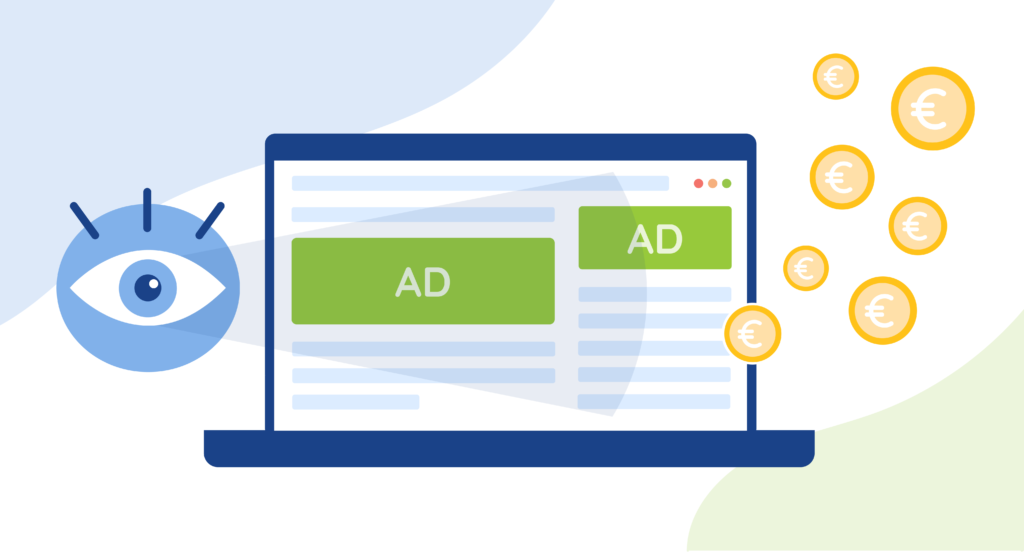“What can’t be measured can’t be improved” – This saying is very relevant in the digital advertising industry where data is the core element. Knowing your metrics means knowing your value. To improve your advertising profitability, a lot of data comes into play, including viewability. In this article, we help you to better understand this KPI and give you 3 ways to improve it.
What is ad viewability?
It is a key metric in programmatic advertising, as it measures the viewability of ads displayed on a site to its users. In other words, it is the number of times an ad is displayed on the user’s screen and seen.
According to the IAB (Interactive Advertising Bureau), a display is considered viewable if it meets a certain number of criteria:
- 50% of a small to medium-sized ad must be seen for at least 1 second by the user.
- 30% of a large ad (over 242,000 pixels) must be seen in the browser window.
- 50% of an instream video must be seen continuously for at least 2 seconds.
This data is available in the Active View reports provided by the Google Ad Manager Ad Server. Other solutions validated by the Media Rate Council (MRC) exist to measure this viewability rate, such as Integral Ad Sciences.
How is it measured and why is it essential to improve your advertising performance?
Advertising viewability is measured as follows:
For buyers, a good viewability rate allows them to verify the effectiveness of the inventories, and it is an essential purchasing criterion. Indeed, this metric allows advertisers to first evaluate the quality of inventories available on publishers’ sites: the more an ad is seen, the better the click-through rate and the conversion rate. Once they have analysed the viewability of a site, they can adjust the value of their advertising offers. Major brands require viewability rates above 70%. To increase your chances of winning them over, make sure you highlight your viewability rate on your media kit and in your Google Ad Manager profile, under Sales > Deals Settings.
The higher your viewability, the better your fill rate and your eCPM. The correlation between viewability and ad revenue is easily observable. Here is a demonstration in our dashboard on an anonymised publisher:
After moving an ad block on 17 September 2021, its viewability rate increased from 62% to almost 70%, and its eCPM increased by 30% within 5 days of implementing this optimisation. This short delay is due to the fact that when buyers select a certain viewability criterion, the data taken into account to filter eligible inventories is the average viewability rate of the last 7 days.
Viewability is therefore part of our plan of attack to optimise media revenues, along with layout, competition, consents, fill rate, and UX. At Opti Digital, the publishers we work with achieve an average of 70% cross-device viewability rate after deploying our 360º solution on their sites, which represents an increase of more than 20 points compared to their initial average viewability.
3 good practices to optimise your viewability rate
It is essential to measure the viewability of each location on each page in order to make precise and effective adjustments to your site’s layout and loading time.
The reporting tool we provide to publishers makes this granular analysis possible. Please take a look at our quick tutorial on ad viewability to understand how we measure this data.
To boost your viewability rate, here are 3 good practices to adopt:
- Optimise ad placement: place ads above the fold, in the heart of the content and at the bottom of the page. Viewability rates are generally high at these locations. Avoid non-sticky top-of-screen positions, as the user quickly moves down the page. To identify high-potential positions on your site and display ads there automatically, we have developed a dynamic ad insertion technology.
- Adjust your ad loading strategy: direct or lazy loading? Adjust the display of your ads according to your content and your users’ navigation. If loading is slow, adjust the lazy loading setting to be faster on photo slideshows and slower on longer consuming editorial content. In our experience, we recommend applying lazy loading to all your ad inventory to improve your SEO and profitability. With the right settings, the increase in eCPM and fill rate will compensate for the loss of views.
- Implement automatic refresh on viewability conditions: Implemented in a granular and controlled manner, dynamic advertising refresh is an excellent way to optimise user experience, viewability and revenue. At Opti Digital, we control in detail the triggering of refreshes: Once the time limit has passed, a refresh is only activated if the ad space is visible on the user’s active screen. Subsequent displays are generally more viewable than the first. In addition, refreshes multiply the number of impressions and will increase your revenues.
To go further in the optimisation of viewability, we carry out A/B testing and measure precisely what is the best possible configuration per page and per advertising slot.
As you can see, advertising viewability is a KPI that should not be forgotten in order to boost your revenues. As a metric that is closely monitored by advertisers, it is essential to optimise it to ensure that you attract the best campaigns and use your advertising potential to the full. Looking for a solution to optimise it? Call on our expertise.

